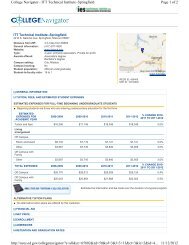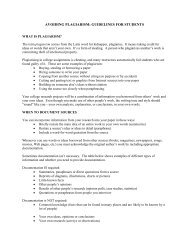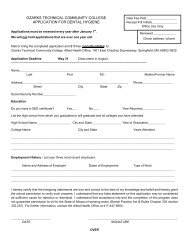Mechatronics Course and Station Outline
Mechatronics Course and Station Outline
Mechatronics Course and Station Outline
- No tags were found...
You also want an ePaper? Increase the reach of your titles
YUMPU automatically turns print PDFs into web optimized ePapers that Google loves.
<strong>Mechatronics</strong> <strong>Course</strong> <strong>and</strong> <strong>Station</strong> <strong>Outline</strong><strong>Mechatronics</strong>Modern industry relies on highly complex production systems to produce high-quality,economical products for an ever dem<strong>and</strong>ing world. <strong>Mechatronics</strong> teaches systems thinking thatis required to effectively operate, program, <strong>and</strong> problem solve in this complex environment. Withthe rapid proliferation of automation technology, mechatronics has become one of the fastestgrowing technical education programs in the world. Many technologies are integrated to makethese sophisticated production systems:• Mechanical• Electrical• Electronics• SoftwareAmatrol’s 870 <strong>Mechatronics</strong> Learning System teaches students a broad array of job-ready skillsin integrating technologies utilizing 7 learning stations. Students work together in a teamenvironment to make the whole process work. Seven stations make up a complete flexiblemanufacturing system. Each station is a small mechatronics system in itself with multiple,integrated technologies that can be used st<strong>and</strong>-alone or in various combinations, creatingunlimited project capability. The 870 Learning System is compact, enabling it to fit into almostany teaching facility. Whether using one station or many, Amatrol’s <strong>Mechatronics</strong> LearningSystem is the ultimate team project!Amatrol’s <strong>Mechatronics</strong> Program will quickly bring your <strong>Mechatronics</strong> program online with theteaching tools you need to get the job done: extensive curriculum in both print-based <strong>and</strong> CD-ROM formats, high quality industrial h<strong>and</strong>s-on training equipment, teacher guides, computerizedclassroom assessment system, installation, on-going service <strong>and</strong> support, <strong>and</strong> teacher training.Amatrol’s <strong>Mechatronics</strong> Program is also unique because it offers:Industrial Components <strong>and</strong> SafetyAmatrol’s <strong>Mechatronics</strong> Learning System uses off-the-shelf industry st<strong>and</strong>ard componentstypical of what learners will see in industry. Recreating the industrial environment in theclassroom helps make students job-ready by building skills using the equipment they will find inthe workplace. Industrial methods <strong>and</strong> components combine so that students learn to do tasksthey will perform on the job.Safety in an industrial setting is critical. The 870 <strong>Mechatronics</strong> System teaches studentsst<strong>and</strong>ard industrial practices <strong>and</strong> methods that support a safe workplace. Emergency stopcircuits meet industrial st<strong>and</strong>ards as does the real world operator panel. Students learn theimportance of lockout / tagout <strong>and</strong> procedures for correct machine start-up, shut-down, <strong>and</strong>emergency stop operation.Wide Array of Advanced TechnologyAmatrol’s <strong>Mechatronics</strong> System covers a broad array of applications across a balance ofmechanical, electrical, electronics, fluid power <strong>and</strong> software to enable students to workeffectively in virtually any industrial setting. The 870 <strong>Mechatronics</strong> system includes eight typesof electronic sensors, three types of electrical motors, four types of pneumatic actuators <strong>and</strong> 20different mechanical power transmission components.Real Product ProductionThe 870 <strong>Mechatronics</strong> Learning System teaches students how to manufacture industrial qualityworking directional control valves. They develop skills needed to enable processes to workPage 1 of 10
<strong>Mechatronics</strong> <strong>Course</strong> <strong>and</strong> <strong>Station</strong> <strong>Outline</strong>together such as making precision physical adjustments. Modern industry leverages technologyso that one set of equipment can make many products. Amatrol’s <strong>Mechatronics</strong> System bringsindustrial realism to the classroom by allowing students to program it to assemble a minimum offour different variations of the valve.Individualized <strong>and</strong> Group Learning FormatsAmatrol’s learning activity packet (LAP) design gives instructors the flexibility to teach studentsusing either a self-directed or traditional lecture-lab format. The LAP design allows labs to beimplemented with a minimum of preparation.Multimedia <strong>and</strong> Printed Curriculum FormatsAmatrol curriculum is well known for its breadth <strong>and</strong> depth of industry-relevant skills. Amatrol’sunique curriculum approach uses a task-based design where theory <strong>and</strong> h<strong>and</strong>s-on activities arestructured around industry-relevant tasks that enable students to develop job-ready skills. Thecurriculum easily supports either traditional lecture-lab format or individualized learning sostudents can learn at their own pace.The 870 <strong>Mechatronics</strong> Learning System boasts a robust ten Learning Activity Packets (LAPs).The first two LAPs concentrate on skills core to all stations: an introduction to mechatronics,systems concepts, safety, machine operation, sensors, pneumatic pick & place, <strong>and</strong> electricalpick & place. Integration skills across multiple stations as well as skills specific to an individualstation are covered in the balance. Overall system skills include discrete I/O h<strong>and</strong>shaking,system start-up / halt, system stop / reset, <strong>and</strong> FMS programming.All stations teach operation, sequencing <strong>and</strong> programming skills. <strong>Station</strong>s can be easily movedapart to function as individual workstations by releasing two quick connects <strong>and</strong> one plug-incable. <strong>Station</strong>s can also be mixed <strong>and</strong> matched, enabling instructors to build <strong>and</strong> change thesystem as budgets allow or needs change. Many station combination’s are available to supportyour needs.Automated Lab ResultsAmatrol’s SkillACE software makes documentation of lab results an easy task for teachers witha computerized data collection system <strong>and</strong> powerful reporting tools.Amatrol’s <strong>Mechatronics</strong> Program Contents• Learning Systems -These systems include h<strong>and</strong>s-on stations with industrial qualitysoftware <strong>and</strong> equipment to provide learning in mechatronics topics.• Printed Curriculum – Each learning system includes a printed curriculum in anindividualized, layered, task-based format.• Interactive Multimedia Curriculum – Various learning systems are available with anoptional interactive multimedia version of the printed curriculum to enhance studentlearning <strong>and</strong> motivation.• Electronic Assessment System – The optional Amatrol SkillACE software automaticallycollects student assessment results <strong>and</strong> organizes them in useful reporting formats.• Teacher Training Services – Amatrol provides tuition-free teacher training for initial <strong>and</strong>on-going professional development of teachers involved in the <strong>Mechatronics</strong> Program.• Service <strong>and</strong> Support Services – Amatrol offers superior service <strong>and</strong> support, includingfree hot-line support <strong>and</strong> knowledgeable local service technicians.Page 2 of 10
<strong>Mechatronics</strong> <strong>Course</strong> <strong>and</strong> <strong>Station</strong> <strong>Outline</strong>Learning System Topics• Mechanical Drives• Fluid Power• Servo Control• Electrical Motor Control• Electronic Drives• Programmable Controllers• Process Control• Robotics• Computer Integrated Manufacturing (CIM)Individual <strong>Station</strong> Detail:• <strong>Station</strong> 1 – Pick <strong>and</strong> Place Feeding• <strong>Station</strong> 2 – Gauging• <strong>Station</strong> 3 – Orientation Processing• <strong>Station</strong> 4 – Sorting / Buffering• <strong>Station</strong> 5 – Servo Robotic Assembly• <strong>Station</strong> 6 – Torque Assembly• <strong>Station</strong> 7 – Inventory StoragePage 3 of 10
<strong>Mechatronics</strong> <strong>Course</strong> <strong>and</strong> <strong>Station</strong> <strong>Outline</strong><strong>Station</strong> 1<strong>Mechatronics</strong> Pick <strong>and</strong> Place Feeding <strong>Station</strong> – 87-MS1Amatrol’s 87-MS1, Pick <strong>and</strong> Place Feeding, is station 1 of the 870 <strong>Mechatronics</strong> Learning System. The 87-MS1station is a small mechatronics system in itself with multiple, integrated technologies that can be used st<strong>and</strong>aloneor in combination with other stations. Industrial safety <strong>and</strong> operation are emphasized on all Amatrolmechatronic stations.The Pick <strong>and</strong> Place Feeding station teaches interfacing, problem solving, programming, sequencing <strong>and</strong>operation for pneumatic robots, material feeding systems, powered parts feeders, vacuum grippers, hall-effectsensors, <strong>and</strong> magnetic sensors. This station starts the process of assembling a working industrial directionalcontrol valve.The 87-MS1 is a mobile workstation with slotted work surface that contains an operator station, powered feedmodule, pneumatic pick <strong>and</strong> place manipulator, finished parts storage module, parts set, a pneumaticdistribution module as well as an electrical distribution module, an electro-pneumatic valve manifold, <strong>and</strong> adigital I/O interface module.• Key Features• Hall-effect sensor• Vacuum gripper• Powered parts feeder• Pneumatic robot• Material feeding system• Magnetic sensor• Photoelectric sensorLearning Topics• Powered Parts Feeder Operation• Shock Absorber Adjustment• Vacuum Switch Adjustment• Vacuum Gripper Adjustment• Material Feeding Systems• <strong>Station</strong> Operation• Electrical Sensors• Electrical Pick <strong>and</strong> Place• Pneumatic Pick <strong>and</strong> Place• <strong>Mechatronics</strong> Safety• Control Systems Concepts• <strong>Mechatronics</strong> Introduction• Pneumatic Manipulator Operation• Powered Parts Feeder Sequencing• Pneumatic Manipulator Sequencing• PLC Program Design for <strong>Station</strong> SequencingPage 4 of 10
<strong>Station</strong> 2<strong>Mechatronics</strong> <strong>Course</strong> <strong>and</strong> <strong>Station</strong> <strong>Outline</strong><strong>Mechatronics</strong> Gauging <strong>Station</strong> – 87-MS2Amatrol’s 87-MS2, Gauging, is station 2 of the 870 <strong>Mechatronics</strong> Learning System. The 87-MS2 station is asmall mechatronics system in itself with multiple, integrated technologies that can be used st<strong>and</strong>-alone or incombination with other stations. Industrial safety <strong>and</strong> operation are emphasized on all Amatrol mechatronicstations.The Gauging station teaches interfacing, problem solving, programming, sequencing <strong>and</strong> operation for go/nogogauging, analog sensor adjustment, non-servo electric traverse axis, synchronous belt drive, ball screwdrives <strong>and</strong> part rejection/transfer. The 87-MS2 performs a number of quality inspections in the process ofassembling a working industrial directional control valve.The 87-MS2 is a mobile workstation with slotted work surface that contains an operator station, ultrasonicmeasurement module, proximity gauging module, part transfer module, part reject module, finished partsstorage module, parts set, a pneumatic distribution module as well as an electrical distribution module, anelectro-pneumatic valve manifold, <strong>and</strong> a digital I/O interface module.• Key Features• Non-servo Electric Traverse Axis• Magnetic Reed Switches• Limit Switches• Photoelectric Sensor• Inductive Sensor• Ultrasonic Sensor• Analog Sensor Adjustment• Go/No-Go Gauging• Synchronous Belt Drive• Ball Screw Drives• Part Rejection/TransferLearning Topics• Ball Screw Drive Adjustment• Synchronous Belt Adjustment• Non-Servo Electric Traverse Axis Travel Adjustment• <strong>Station</strong> Operation• Electrical Sensors• Electrical Pick <strong>and</strong> Place• Pneumatic Pick <strong>and</strong> Place• <strong>Mechatronics</strong> Safety• Control Systems Concepts• <strong>Mechatronics</strong> Introduction• Non-Servo Electric Traverse Axis Sequencing• Part Reject Module Sequencing• Go/No-Go <strong>Station</strong> Sequencing• PLC Program Design for <strong>Station</strong> SequencingPage 5 of 10
<strong>Station</strong> 3<strong>Mechatronics</strong> <strong>Course</strong> <strong>and</strong> <strong>Station</strong> <strong>Outline</strong><strong>Mechatronics</strong> Orientation-Processing <strong>Station</strong> – 87-MS3Amatrol’s 87-MS3, Orientation-Processing, is station 3 of the 870 <strong>Mechatronics</strong> Learning System. The 87-MS3station is a small mechatronics system in itself with multiple, integrated technologies that can be used st<strong>and</strong>aloneor in combination with other stations. Industrial safety <strong>and</strong> operation are emphasized on all Amatrolmechatronic stations.The Orientation-Processing station teaches interfacing, problem solving, programming, sequencing <strong>and</strong>operation for index tables, stepper motors, homing sensors, fiber optic sensors, part transfer, parts orientation,<strong>and</strong> capacitor sensors. This station performs the role of parts orientation <strong>and</strong> an optional simulated machineoperation in the process of assembling a working industrial directional control valve.The 87-MS3 is a mobile workstation with slotted work surface that contains an operator station, 8-station rotaryindex table, pick <strong>and</strong> place pneumatic robot, fiber optic gauging module, part transfer module, finished partsstorage module, parts set, a pneumatic distribution module as well as an electrical distribution module, anelectro-pneumatic valve manifold, <strong>and</strong> a digital I/O interface module.• Key Features• Stepper Motors• Homing Sensors• GMR (Giant Magnetoresistive) Sensors• Inductive Sensors• Capacitive Sensors• Parts Orientation• Part Transfer• Index TablesLearning Topics• Part Transfer Module Sequencing• Homing Sensor Adjustment• Stepper Motor Controller Programming• Capacitive Sensor Adjustment• Fiber Optic Sensor Adjustment• <strong>Station</strong> Operation• Electrical Sensors• Electrical Pick <strong>and</strong> Place• Pneumatic Pick <strong>and</strong> Place• <strong>Mechatronics</strong> Safety• Control Systems Concepts• <strong>Mechatronics</strong> Introduction• Stepper Motor Index Table Sequencing• Parts Orientation Sequencing• <strong>Station</strong> SequencingPage 6 of 10
<strong>Station</strong> 4<strong>Mechatronics</strong> <strong>Course</strong> <strong>and</strong> <strong>Station</strong> <strong>Outline</strong><strong>Mechatronics</strong> Sorting-Buffering <strong>Station</strong> – 87-MS4Amatrol’s 87-MS4, Sorting-Buffering, is station 4 of the 870 <strong>Mechatronics</strong> Learning System. The 87-MS4station is a small mechatronics system in itself with multiple, integrated technologies that can be used st<strong>and</strong>aloneor in combination with other stations. Industrial safety <strong>and</strong> operation are emphasized on all Amatrolmechatronic stations.The Sorting-Buffering station teaches interfacing, problem solving, programming, sequencing <strong>and</strong> operation forsorting, queuing, flat belt conveyors, photoelectric sensors, <strong>and</strong> inductive sensors. This station performs therole of sorting parts by material type in the process of assembling a working industrial control valve.The 87-MS4 is a mobile workstation with slotted work surface that contains an operator station, belt conveyormodule, part sorting module, buffer module, proximity sensing module, parts set, a pneumatic distributionmodule as well as an electrical distribution module, an electro-pneumatic valve manifold, <strong>and</strong> a digital I/Ointerface module.• Key Features• Photoelectric Sensors• Flat Belt Conveyors• Queuing• Sorting• Inductive SensorsLearning Topics• Photoelectric Sensor Adjustment• Flat Belt Conveyor Adjustment• <strong>Station</strong> Operation• Electrical Sensors• Electrical Pick <strong>and</strong> Place• Pneumatic Pick <strong>and</strong> Place• Manual Operation• Machine Operator Functions• <strong>Mechatronics</strong> Safety• Control Systems Concepts• <strong>Mechatronics</strong> Introduction• Sorting Module Sequencing• Parts Queuing Module Sequencing• PLC Program Design for <strong>Station</strong> SequencingPage 7 of 10
<strong>Mechatronics</strong> <strong>Course</strong> <strong>and</strong> <strong>Station</strong> <strong>Outline</strong><strong>Station</strong> 6<strong>Mechatronics</strong> Torque Assembly <strong>Station</strong> – 87-MS6Amatrol’s 87-MS6, Torque Assembly, is station 6 of the 870 <strong>Mechatronics</strong> Learning System. The 87-MS6station is a small mechatronics system in itself with multiple, integrated technologies that can be used st<strong>and</strong>aloneor in combination with other stations. Industrial safety <strong>and</strong> operation are emphasized on all Amatrolmechatronic stations.The Torque Assembly station teaches interfacing, problem solving, programming, sequencing <strong>and</strong> operation foran automated torque system, electric traverse slide, DC motor torque, variable speed motors <strong>and</strong> clutches.This station assures that the assembly components are properly tightened in the process of assembling aworking industrial directional control valve.The 87-MS6 is a mobile workstation with slotted work surface that contains an operator station, screw torquemodule, part clamp module, electric traverse module, a pneumatic distribution module as well as an electricaldistribution module, an electro-pneumatic valve manifold, <strong>and</strong> a digital I/O interface module.• Key Features• Variable Speed Motors• Clutches• Electric Traverse Slide• Inductive Sensor• Magnetic Reed Switches• Variable Speed PWM (Pulse Width Modulator)• Pneumatic Gripper• DC Motor Torque• Automated Torque SystemLearning Topics• Motor Starter Overload Adjustment• Motor Torque Adjustment• Non-Servo Electric Slide Adjustment• DC Motor Speed Adjustment• <strong>Station</strong> Operation• Electrical Sensors• Electrical Pick <strong>and</strong> Place• Pneumatic Pick <strong>and</strong> Place• <strong>Mechatronics</strong> Safety• Control Systems Concepts• <strong>Mechatronics</strong> Introduction• Non-Servo Electric Slide Sequencing• Torque Clamp Module Sequencing• <strong>Station</strong> SequencingPage 9 of 10
















